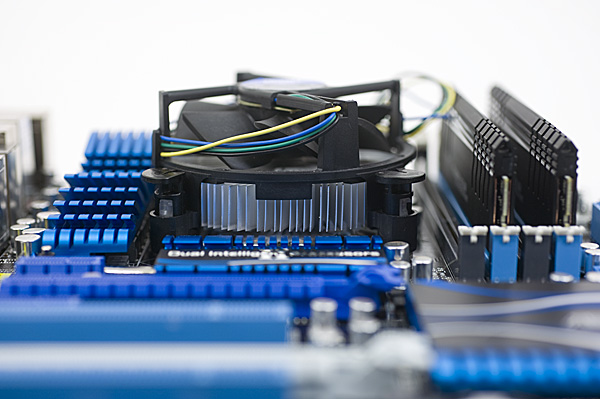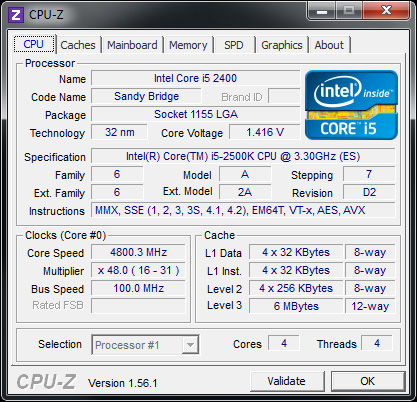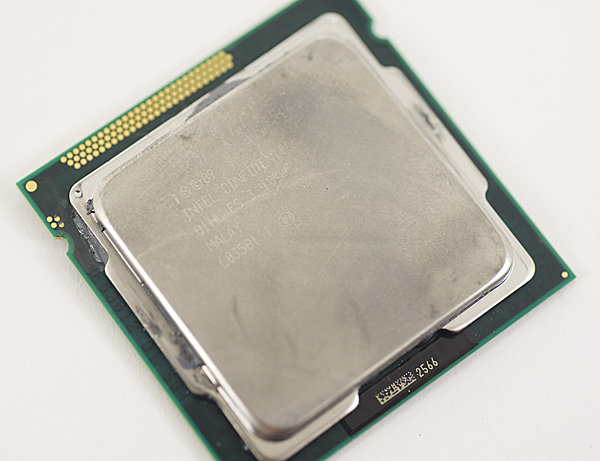The Sandy Bridge Review: Intel Core i7-2600K, i5-2500K and Core i3-2100 Tested
by Anand Lal Shimpi on January 3, 2011 12:01 AM ESTOverclocking, the K-Series and What You’ll Want to Buy
If you haven’t noticed, the computing world is becoming more integrated. We review highly integrated SoCs in our smartphone coverage, and even on the desktop we’re seeing movement towards beefy SoCs. AMD pioneered the integrated memory controller on desktop PCs, Intel followed suit and with Lynnfield brought a PCIe controller on-die as well. Sandy Bridge takes the next logical step and brings a GPU on-die, a move matched by AMD with Brazos and Llano this year.
In the spirit of integration, Intel made one more change this round: the 6-series chipsets integrate the clock generator. What once was a component on the motherboard, the PLL is now on the 6-series chipset die. The integrated PLL feeds a source clock to everything from the SATA and PCIe controllers to the SNB CPU itself. With many components driven off of this one clock, Intel has locked it down pretty tight.
With Nehalem and Westmere, to overclock you simply adjusted the BCLK from 133MHz to whatever speed you wanted and sometimes toyed with multipliers to arrive at a happy end result. With Sandy Bridge, the BCLK generated on the 6-series PCH is at 100MHz by default and honestly won’t go much higher than that.
While I’ve heard reports of getting as high as 115MHz, I’d view 103—105MHz as the upper limit for what you’re going to get out of BCLK overclocking. In other words: next to nothing. A 105MHz BCLK overclock on a Core i7-2600 will take you from a stock speed of 3.4GHz to a whopping 3.57GHz. The form of overclocking we’ve been using for the past decade is effectively dead on Sandy Bridge.
Years ago, before the Pentium II, we didn’t rely on BCLK (or back then it was just FSB or bus overclocking) to overclock. Back then, if we wanted a faster CPU we’d just increase the clock multiplier. Intel has dabbled in offering multiplier unlocked parts for overclockers, we saw this last year with the Core i7 875K for example. With Sandy Bridge, those unlocked parts are going to be a lot more important to overclockers.
It works like this. If you have a part that does not support Turbo (e.g. Core i3-2100 series), then your CPU is completely clock locked. You can’t overclock it at all, have fun at your stock frequency. This is good news for AMD as it makes AMD even more attractive at those price points.
If you have a part that does support turbo (e.g. Core i5-2400), then you have what’s called a “limited unlocked” core—in other words you can overclock a little bit. These parts are limited to an overclock of 4 processor bins above and beyond the highest turbo frequency. Confused yet? This chart may help:
In this case we’re looking at a Core i5-2500, which runs at 3.3GHz by default. When a single core is active, the chip can turbo up to 3.7GHz. If you want, you can change that turbo state to go as high as 4.1GHz (if your CPU and cooling can keep up).
Overclocking these limited unlocked chips relies entirely on turbo however. In the case above, the fastest your chip will run is 4.1GHz but with only one core active. If you have four cores active the fastest your chip can run is 3.8GHz. While Intel didn’t sample any limited unlocked parts, from what I’ve heard you shouldn’t have any problems hitting these multiplier limits.
There’s a third class of part: a fully unlocked K-series chip. At launch there are only two of these processors: the Core i5-2500K and the Core i7-2600K. Anything with a K at the end of it means you get all multipliers from 16x all the way up to 57x at your disposal. It’s effectively fully unlocked.

These chips overclock very well. Both my Core i5-2500K and Core i7-2600K hit ~4.4GHz, fully stable, using the stock low-profile cooler.

This is all you need for 4.4GHz
With a bit more effort and a better cooler, you can get anywhere in the 4.6-5.0GHz range:

It's a bit too early to tell how solid these near-5GHz overclocks will be, but I'm confident in the sub-4.5GHz overclocks we were able to sustain.
You do pay a price premium for these K-series SKUs. The 2500K will cost you another $11 over a stock 2500 and the 2600K costs an extra $23. In the case of the 2500K, that’s a small enough premium that it’s honestly worth it. You pay $11 extra for a chip that is very conservatively clocked and just begging for you to overclock it. Even the 2600K’s premium isn’t bad at all.
| Model Number | Standard SKU | K-Series SKU | Price Premium |
| Intel Core i7-2600 | $294 | $317 | +$23 |
| Intel Core i5-2500 | $205 | $216 | +$11 |
As an added bonus, both K-series SKUs get Intel’s HD Graphics 3000, while the non-K series SKUs are left with the lower HD Graphics 2000 GPU.
Compared to Lynnfield, you’re paying $11 more than a Core i5-760 and you’re getting around 10-45% more performance, even before you overclock. In a perfect world I’d want all chips to ship unlocked; in a less perfect world I’d want there to be no price premium for the K-series SKUs, but at the end of the day what Intel is asking for here isn’t absurd. On the bright side, it does vastly simplify Intel’s product stack when recommending to enthusiasts: just buy anything with a K at the end of it.
Since we’re relying on multiplier adjustment alone for overclocking, your motherboard and memory actually matter less for overclocking with Sandy Bridge than they did with P55. On both P67 and H67, memory ratios are fully unlocked so you can independently set memory speed and CPU speed. Even the GPU ratios are fully unlocked on all platforms and fully independent from everything else.












283 Comments
View All Comments
krazyderek - Monday, January 3, 2011 - link
putting the 3000 on the the 2600k and 2500k parts ALMOST made sense as an up-sell, but you can't even use their IGP when on a P series board when you're overclocking! If the Z series wont' be out for a while why the hell would i buy an overclocking chip now? so i can spend more money to replace my H series motherboard with a Z series? Nice try.It's frustrating that you have to pick your sacrifice.... you either get the 3000 with the K sku, or you get VT-d and TXT with the standard sku. Intel doesn't have an offering with both which is kind of ridiculous for high end chips.
mino - Wednesday, January 5, 2011 - link
Yeah, what is most disappointing is lack of Virtualization support even from i3's (!)For christ's sake, Virtualization is the most BASIC requirement for any box today and even s775 Pentium, not to mention the WHOLE AMD lineup have it!
For me this means nothing sub-i5 is useable in ANY capacity, business or private while i5 are (financially) and overkill for most uses.
Well done Intel. You have just lost ~100 $100 certain sales this year. Whatever, will have to wait for Llano for the mainstream stuff.
DrSlothy - Wednesday, January 12, 2011 - link
I think that's an error in the review table, though one I've seen in every Core review so far - did Intel marketing give out wrong specs?Intel website shows the entire Sandy Bridge line-up to have Hardware Virtualisation (VT-x) support, though some are missing VT-d
tech6 - Monday, January 3, 2011 - link
Another great review from Anandtech - thanks guys.It seems odd that the 3000 series graphics engine would be only included on a part designed for over clocking and the boards that support overclocking can't handle integrated graphics. I would have thought that the other way around would have made more sense.
In any case the 2600K and 2500K look like great value parts and are just what I was waiting for!
DanNeely - Monday, January 3, 2011 - link
Does anyone know if QuickSync will appear on LGA-2011 chips? I know they aren't going to have the general purpose GPU components, but this is enough of a performance booster that I'd think Intel would want to keep it on their high end consumer platform in some fashion.ThaHeretic - Monday, January 3, 2011 - link
I see TXT in the last chart above with no explanation as to what it is or why it is differentiated. They -took out- functionality from the unlocked parts? That seems backwards...Kevin G - Monday, January 3, 2011 - link
This functionality will likely appear in Sandybridge Xeons for socket 1155. Intel *generally* segments the Xeons by core count and clock speed, not by feature set like they do for consumer chips. The other feature Intel is holding back is ECC which should be standard in socket 1155 Xeons.DanNeely - Monday, January 3, 2011 - link
It's a hardware security feature. It's best known for the Trusted Platform Module; an on board cryptographic device used in some corporate computers but not used in consumer systems. Probably they just want to keep people from building high end secure servers with cheap, overclocked K parts instead of the much more profitable XEONs for 2-3x as much.http://en.wikipedia.org/wiki/Trusted_Execution_Tec...
kache - Monday, January 3, 2011 - link
I think I'll wait for the SB xeons and the new EVGA SR-2, hoping that EVGA will release it.adrien - Monday, January 3, 2011 - link
Numbers will probably speak by themselves. ;-)17:37 ~ % md5sum *.png
bee3c83b3ef49504e0608a601a03bfc2 6870.png
bee3c83b3ef49504e0608a601a03bfc2 snb.png
So the 6870 and cpu-rendering have the same image.